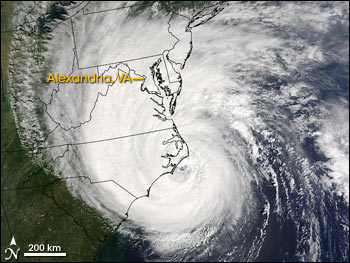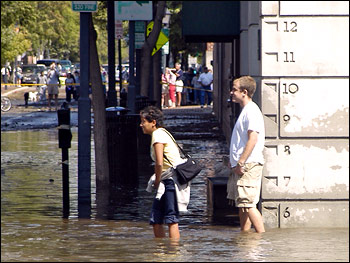

 | |||
The wide and smooth Potomac River flows lazily past the marble and concrete structures of Washington, D.C., and bends south in its course to the Chesapeake Bay. Before it reaches Mount Vernon, the hillside plantation that once belonged to the first president of the United States, the river flows through tree-lined parks and forest that hides quiet suburban neighborhoods. Kirsten and Graham McCoulloch and their two young sons live in one such neighborhood, a full six blocks, a highway, and a riverside park away from the river’s edge. On September 18, 2003, the family was at home waiting for Hurricane Isabel to blow over when the word came to evacuate. “They told us, ‘Go fast because we don’t want you driving during the storm,’” recalls Kirsten. “The next day, we couldn’t get near our neighborhood.” Flood water had rushed up from the Potomac and pooled around their house. A neighbor swam to his house and returned in a canoe. “He told us, ‘It’s worse than you can imagine. The water is as deep as the kitchen counters,’” says Kirsten. |
|||

The McCoullochs knew that their home was in a floodplain, but it was a 100-year floodplain. There had been some flooding in the 1960s, but since then, a dyke system had been installed to keep the neighborhood dry. The couple did not think their home was in danger and, in fact, had been reassured by neighborhood rumors that the community’s floodplain status might be lifted. Graham returned to the house a few days after the hurricane struck to find debris—trash, tree branches, household items—strewn everywhere. “The smell alone was so awful you couldn’t get near the house,” says Kirsten. Sewage and grime had mixed with the flood water and splashed through the house. On top of that, mildew formed on the walls and the contents of the house. “Everything was black.” |
As Hurricane Isabel moved inland from the Atlantic coast, it pushed a surge of water northwards into the Chesapeake Bay. The storm surge flooded many cities and towns on the shores of the bay and along its low-lying tributaries, including Alexandria, Virginia. (Image courtesy Jacques Descloitres, MODIS Rapid Response team) | ||

It was mid-May 2004 before the family could start to re-build and a full year before they returned to their home. Although the McCoullochs had flood insurance and qualified for assistance from the Federal Emergency Management Agency (FEMA), they still had to take out a loan to cover the cost of rebuilding. “The water was only three feet deep. The insurance agency only paid for that,” explains Kirsten. The damages to the house alone cost well over $50,000, and that didn't include the additional expenses of rebuilding their lives. They had to repair the walls where the water splashed above three feet, buy new household items, pay for temporary housing, and re-landscape the yard. They had lost nearly everything. The McCoullochs aren’t the only ones staggering under the expense of cleaning up after natural disasters. Munich-Re, the world’s largest re-insurance agency, reports that disaster-related economic losses topped US $145 billion in 2004, up from $65 billion in 2003, for about the same number (650) of natural disasters in each year, making 2004 the most expensive year to date. While the loss of human life from the devastating Asian tsunami is overwhelming, the economic cost was an estimated $10 billion. The majority of the losses in 2004 were caused by weather-related events: a string of powerful hurricanes in the Atlantic, a record 10 typhoons in Japan, and flooding across the globe. Is the rising cost of natural disasters an anomaly or part of an alarming trend? As recently as the 1950s, the average cost of catastrophic events was a mere $3.9 billion per year. The cost of natural disasters is increasing, and some companies like Munich-Re say climate change is partly to blame. Others say that human factors like population growth and land use have more to do with the rising costs. Global climate models do predict that a warmer climate could lead to higher sea levels and coastal flooding, more intense storms, deadly heat waves, and more extreme flood-drought cycles in the twenty-first century. But what about today? Has humanity already begun to bear the cost of climate change? |
At the height of the flooding downtown Alexandria, Virginia, was inundated by as much as 6 feet of water. Residents were allowed back to their homes only after the water had subsided. (Photograph courtesy Federal Emergancey Management Agency Photo Library) | ||
 | |||
“Don’t blame global warming yet,” warns William Patzert with an emphasis on yet. The Earth’s climate has always changed, and will continue to do so, explains the oceanographer and climatologist from NASA’s Jet Propulsion Laboratory. Global warming will likely impact natural disasters in the next 100 years, but Patzert isn’t convinced that the rising cost seen in the past few years can be directly attributed to climate change. “It’s a controversial topic. There’s not much hard evidence to demonstrate that natural disasters are any worse now than they were in the past,” he says. “The twentieth century was relatively benign in comparison to the past. We’ve had worse volcanic eruptions, more severe storms, worse drought [in the past]. What overwhelms us is population.” |
Since 1950, the cost of natural disasters worldwide has increased dramatically. Is this increase the result of disasters increasing in frequency and severity, or is there another cause, such as the growing human population? (Graph by Robert Simmon, based on data courtesy EM-DAT: The OFDA/CRED International Disaster Database (www.em-dat.net) Université Catholique de Louvain—Brussels, Belgium) | ||